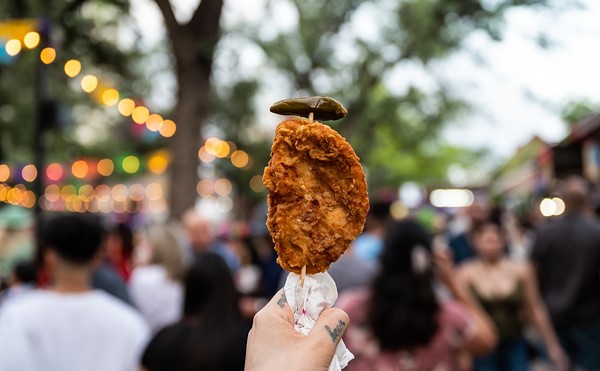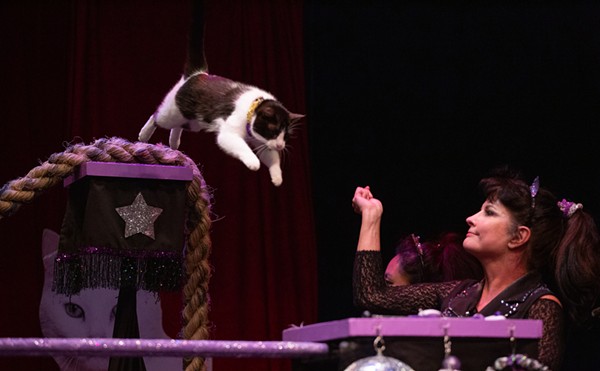
On Monday afternoon, on her first day on the job, Blue Star Contemporary Art Museum’s new executive director, Mary Heathcott, responded thoughtfully to my barrage of pointed questions. She was well aware of the challenges facing the place (which I’ll get to in a moment), but was most diplomatic, which is wise.
Back in 2011, in the chaotic days just after the ouster of Artpace’s then-director Matthew Drutt, she struck me as similarly circumspect. From a mysanantonio.com blog post by Steve Bennett, the week of the upheaval: “Asked if the development was unexpected or a long time coming, interim managing director Mary Heathcott said, ‘I’m going to decline to comment on that.’”
During her tenure there, Heathcott had to contend with one of the most turbulent periods in Artpace history. She not only had to tamp down the Drutt drama, but also weather the sudden resignation by subsequent Executive Director Regine Basha due to a medical condition just a few months later and a handover in leadership at the Linda Pace Foundation, the primary organization that funds Artpace, from Steven Evans to Maura Reilly. That’s a lot of regime change in three years. On the operational side, the International Artist-in-Residence program, with the countless variables involved in its changing artist roster and simultaneous in situ projects, continued, as did the community potlucks and public openings. Chalk It Up expanded. Artpace got a sizable NEA grant in 2012.
It’s a vast oversimplification to state that Heathcott was the only glue holding this vast enterprise together; Artpace pillars such as studio director Riley Robinson and savvy board member Travis Capps were on hand. But you can insert the old chestnut here about windblown sails, choppy seas and steady sailing—with Heathcott at the helm.
In our interview, Heathcott credited the work of predecessors Executive Director Bill FitzGibbons and Consulting Manager Steven Evans, and spoke enthusiastically about the board of directors with whom she’ll be working. Importantly, she relied on few platitudes about art in the community and demonstrated a surprising amount of nitty-gritty. When asked about Blue Star’s educational mission, she answered as half-idealist and half policy-wonk. “MOSAIC could benefit from more exposure for what they’re doing, and should be better-integrated into [Blue Star]’s overall program,” she said, citing the art education’s graduation percentage and founder/director Alex Rubio’s role as a mentor. “The numbers they’re posting [about what] the mentored students have gone on to do as artists are amazing; it’s the kind of hard metric you can communicate to funding organizations.”
Also on her long-term agenda for the Museum: a sustained effort to cultivate local collectorship, oversee a spate of hiring and strengthen community development both through “open collaboration and partnering with peer organizations,” and “an ongoing dialogue with the city.” She has even given creative thought to organize 25 years of potential archive material.
The workload is frankly daunting in any case. But to add to the organizational complexity, Blue Star not unlike Artpace in 2011, has been in a bind.
I’ve observed the public face and barely-concealed drama of Blue Star since 2008, and in the past six years, it’s served me as much chisme as art. I’ve been privy to grousing from current and former board members, volunteers, employees and artists—often alcohol-fueled, always off the record. The boilerplate was this: Blue Star existed as a hidebound provincial playground for rich patrons; board members more interested in art than social currency feared rocking the boat for fear of career repercussions; Blue Star threw local artists a bone occasionally, via inclusion in Red Dot or Arts and Eats, but behaved mostly as a frustratingly closed circuit without much accountability or ready access; and its director, Bill FitzGibbons, used the organization in part as a platform to bolster his art career.
San Antonio’s art institutions are prone to oligarchy. Maybe it’s a perverse relic of the Spanish patron system; arts institutions that should and could benefit a whole community serve instead to advance the career or social ambitions of the few, and big guns run public and private institutions as private fiefdoms. Take Henry R. Muñoz III at the Museo Alameda. He gave, via the imprimatur of the Smithsonian, and took away, via grandstanding and questionable partying. Or the aforementioned Matthew Drutt, a gifted and well-connected curator, who nevertheless drew criticism for an autocratic managerial style, big travel budgets and art fair wheeler-dealing.
This system of sclerotic fiefdoms is true in other cities, of course—witness Jeffrey Deitch’s controversial tenure at the Museum of Contemporary Art in Los Angeles as a bigger-picture example. But in San Antonio, and at Blue Star, an oligarchy is particularly damaging since we’ve got so few resources in terms of exhibition space and career-building venues. Further, San Antonio is bidding for relevant, big-city cred and national presence and parochial turf wars, backbiting and institutional failure undermine our cultural clout.
That’s not to say everything in Blue Star’s recent past was bad. Bill FitzGibbons was seen to conflate his role as executive director with exhibiting artist, and it was unwise for him to promote his own work in conjunction with the Museum. But he also led the place for 11 years and saw the inception of MOSAIC, the Berlin residency, a marquee venue for the Texas Biennial and the rise of a Blue Star so powerful it acted as the epicenter of a Southtown arts boom, including the First Friday juggernaut. He’s also not the only artist to lead an arts organization in SA; part of the problem may be our community expecting creative thinkers to stifle their professional art ambitions and focus instead on prosaic administrative duties.
Also, the social focus, however marked by in-crowdism, has significant upsides. Red Dot and Arts and Eats are not just important on the SA art scene social calendar, they raise legit money for the Museum, and they afford at least some exposure to local artists who donate or consign work. Fundraising is paramount; Blue Star, a nonprofit 501(c)3, hasn’t got a university affiliation a la UTSA, a satellite membership in a larger nonprofit network like the Smithsonian that the Alameda had (and squandered), and sure didn’t start out with a Linda Pace-sized endowment. The parties aren’t for nothing, and they’re something to build on.
Still, there’s other significant wrinkles for Heathcott far different than her Artpace days. Though it’s died down a bit, there remains an atmosphere of controversy surrounding James Lifshutz’s development of the Blue Star Arts Complex, dislodging Jump-Start Performance Co. and the Cactus Bra-Three Walls-Stella Haus trio of woman-owned galleries. With Lifshutz’s repeated public declaration that “Art will remain the primary component of the area,” in a very real way, Blue Star Contemporary Art Museum has to work in order to legitimize the whole development enterprise.
Add to this the fact that the entrance to the complex, on the torn-up patch of South Alamo, deters all but seriously-dedicated visitors and that the timeframe for the new pedestrian-friendly sidewalks is wobbly. The art activity in other areas of the city, including the Beacon Hill flowering and On and Off Fredericksburg growing in strength, dilutes some focus, too.
It’s not just Lifshutz with a stake; everybody in San Antonio who cares about contemporary art needs the damn thing to work. The gallery system, which I’ve noted in a previous piece, is in promising disarray, but disarray nevertheless. And with last week’s sudden parting of the San Antonio Museum of Art and David Rubin, I’m worried that SAMA is rededicating focus to antiquities and the existing collection over Rubin’s evident efforts in opening it to local contemporary work. Rubin made his presence felt at nearly every major exhibition and event in the community, and his email advisements about opportunities open to local art makers, as well as his public artist talks, have become invaluable. I hope another institution finds use for his talent, advocacy and dedication, because narrowing the number of opportunities for working artists is the last thing we need. I worry that we’re hemorrhaging artists, even as the city has introduced some innovative and commonsensical guidelines for expanded arts funding.
All this is to say I’m optimistic about Heathcott as Executive Director at Blue Star. No one person can be a solution—this is the kind of thinking that leads to oligarchic fiefdoms in the first place—but Heathcott’s track record at Artpace has demonstrated real bona fides, and her Blue Star leadership strikes a hopeful note. But will she be able to help overhaul a creaky organization, or was it run as a cliquey, top-down fiefdom for too long?
The burden seems comically huge, but I think she might handle it. Current and former board members exhibited a consensus; she’s smart, capable and a good combination of conceptual strength and administrative know-how.
Penelope Spier, vice chair of Blue Star’s educational committee and head of arts nonprofit 04Arts, says of Heathcott, “It’s a total paradigm shift. Mary can truly communicate with people [and is capable of] creative cooperation—women have relational skills that relate to the future of Blue Star and the future of the art world, [where] the currency is the idea, not the object.”
At Artpace, Heathcott had to navigate a tenuous relationship between outward-looking, art-world prominence and the overlooked needs of local artists. She’s got chops as a curator, having developed Artpace’s Window Works and Hudson (Show)Room presence, managing the logistical variables while opening the organization to innovative work by rising local artists. She’s well versed in dealing with boards, Lord knows. Her master’s degree from the University of Chicago raises her art-world cred. She’s been on the scene for eight years and has made her home here, in Southtown.
What this all amounts to is resolute non-oligarchy. Heathcott has professional ambitions, hopefully; she’s not much use to us if she hasn’t. But a combination of curatorial savvy and organizational know-how, her experience relying on her own map when the existing framework goes awry, stands us in pretty good stead. This is but the beginning; I’m setting out the dilemma and the promise. Blue Star should be rooted for rather than resented. Enough with the chisme; make some proposals.















